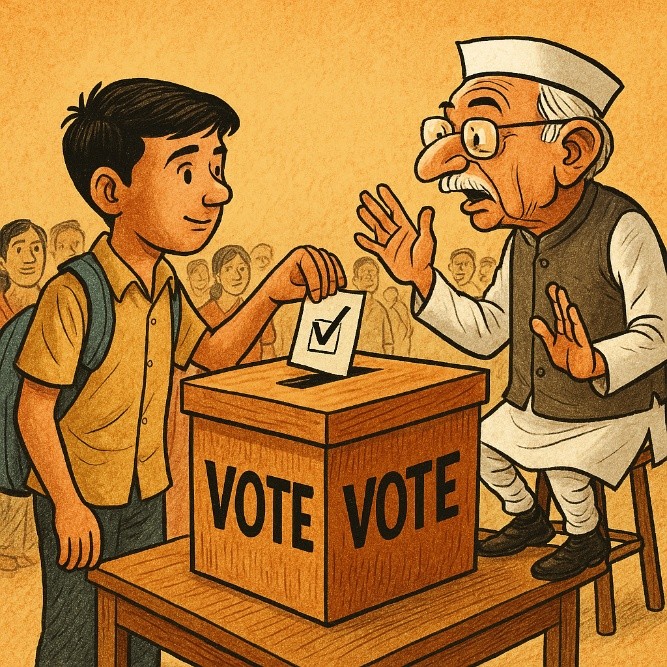



The UK just lowered its voting age to 16. Should India follow suit? Maybe—but only if we’re ready to prepare the voter and reform the system, not just expand it.
Sixteen is a funny age. You’re old enough to be told to act mature, too young to legally drink, and—until now in most places—not old enough to vote.
But that’s changing. The UK has just become the latest country to lower the voting age to 16, following Austria, Scotland, and parts of Latin America. The reasons sound right: teenagers work, pay taxes, take public transport, follow news (sometimes better than their parents), and are deeply affected by laws. Why shouldn’t they help shape them?
As usual, the idea is now floating toward India. We’re the youngest major democracy in the world—shouldn’t we also be the boldest?
Maybe. But only if we’re honest about what that would actually mean.
The Indian Teenager Isn’t Politically Illiterate—Just Overloaded
At 16, the average Indian teenager is juggling exam stress, tuition classes, college entrance forms, parental expectations, and the mild existential panic of having to choose “Science, Commerce, or Arts.”
They’re not scanning policy documents. They’re not dissecting the fiscal deficit. They may have opinions, but the system doesn’t show them what to do with those opinions.
Civics in Indian schools is often a footnote—dry, distant, and forgotten after the exam. There’s no space for mock elections, no habit of debating public issues, and no safe sandbox to understand what governance actually means.
So yes, they may know who Nehru was. But they don’t know how their ward councillor affects the road outside their house.
If India Lowers the Voting Age, Here’s What May Happen
Expect parties to field a few college toppers, social media darlings, or maybe someone with 200k followers and a clean haircut. But behind the curtain? The gatekeepers remain the same.
There might be fresher voices and better lighting on campaign posters. But the core decisions in most parties still rest with the same familiar circles. The baton isn’t being passed—it’s just being polished and loaned out for the season.
Political parties adapt fast. The moment 16-year-olds get the vote, campaigners will start showing up at coaching hubs, youth expos, and school gates—with promises of free data, digital skilling, and “youth entrepreneurship” banners.
The packaging might change. The messaging might get an update. But the machinery? That’ll mostly keep doing what it knows best.
There’s always hope that young voters will bring new energy. And in places like Austria and Scotland, early enfranchisement did see promising turnout. But India has a different story.
Urban India already has a turnout problem. Cities like Mumbai, Bengaluru, and Delhi often record voter turnout under 55%, sometimes worse. For many, elections feel like background noise—important in theory, but unlikely to touch their daily lives.
Adding millions of teenagers to the rolls might not fix that. We may get more names on paper, but whether that turns into a meaningful vote is another matter altogether.
Will This Clean Up the Dirty Bits of Indian Elections?
Probably not.
Vote buying isn’t likely to disappear. It may just adapt. Teenagers don’t need hard cash—sometimes all it takes is a phone recharge, a game token, or a cricket cap. The mechanics evolve. The mindset rarely does.
As for caste politics—well, let’s just say many young Indians grow up knowing their surname, sub-caste, and voting preference long before they know the Constitution’s preamble. Voting earlier might not liberate them from this—it could simply get them on the rolls a little sooner.
If change is to come, it won’t be from the vote itself—but from how we prepare voters to use it.
We’ve Been Here Before. Did We Learn Anything?
India lowered its voting age from 21 to 18 in 1988—a bold, progressive move on paper. But we didn’t do much groundwork then either. No large-scale civic education, no serious voter preparation, and no attempt to clean up the political culture that awaited them.
We gave the youth the vote—but mostly to swell rally crowds, not representation. Before we do it again, we need to ask: what’s changed? And how sure are we that we’ll do better this time?
Can This Be Done Right?
Possibly. But only if we’re prepared to do the groundwork.
Lowering the voting age sounds like a democratic leap forward—and it can be—but only if it’s backed by serious thought, not just a press note or a committee nod.
It would require:
So, Should India Lower the Voting Age?
It depends.
India doesn’t just have a trust problem. It has a turnout problem too. And it’s not just in dusty villages—it’s in gated communities and business lounges, where the politically aware often opt out, convinced nothing will change.
If we want to bring 16-year-olds into this system, we have to fix what they’re stepping into. We need to show that their vote can push politics from “candidate net” to “constituency best”—not just who wins, but how well they serve.
And even there, let’s keep our expectations realistic. One good candidate won’t rewrite the script. Elected representatives still follow party lines, vote as they’re told, and mostly speak when allowed. But a younger voter base might start asking tougher questions—and that alone can shift the tone.
Final Thought
Letting 16-year-olds vote isn’t just about trusting them. It’s also about proving we deserve their trust. We’ve already given them dreams, deadlines, and pressure. If we’re now going to give them the ballot too, let’s make sure we’re offering more than just another number on a voter list.
So yes, maybe let them vote. But first, give them something worth voting for.